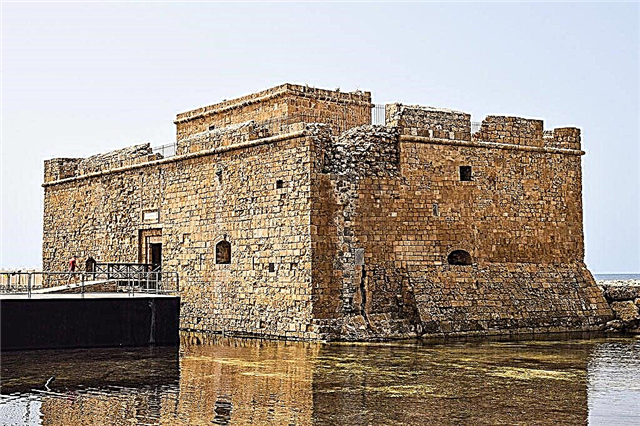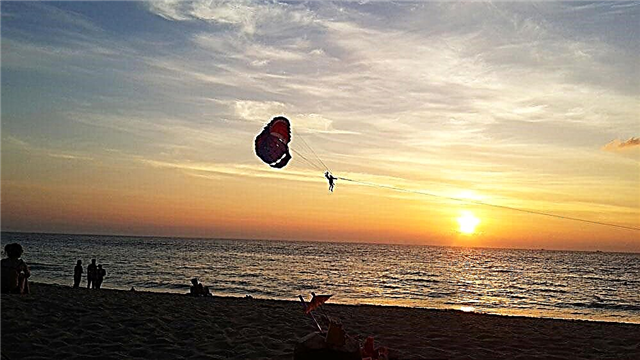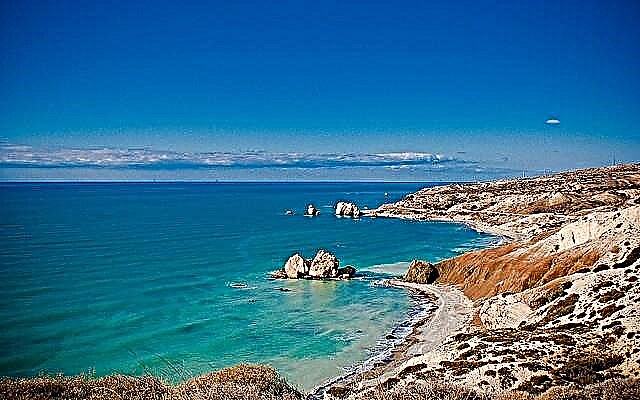There are many attractions to visit and see in Paphos. It is better to do it on your own in order to truly enjoy the beauty of Cyprus without spending money on excursions.
Archaeological Park (Kato Pafos Archaeological Park)
One of the main attractions of Paphos. The park is a must-see for all lovers of antiquities. The archaeological park is under the protection of UNESCO and is remarkable for its mosaics that date back to the 2nd-5th centuries. n. e. Some of them are in the open air, and some in special rooms. In addition to the famous mosaics, in the park you can admire the ruins of the Saranda Kolones castle, Agora, Odeon, Asklepion and other antiquities.
The archaeological park is very atmospheric, especially if you come to the opening or closing when there are no tourists and it is not so hot. The main entrance to the park is located near the port, there is a parking nearby. The ticket price is 4.5 euros, it takes an average of 2-3 hours to see the park.
Required wear hats and comfortable shoes, and bring water and sunscreen. There is a map of the park and a free toilet at the entrance, and behind the exhibition pavilion, where guidebooks and other printing materials are sold, you can get water if you first take a container, because drinking water on the embankment is expensive - 1.5 euros for 0.5 liters. The park is open from 8 am to 7:30 pm (June-August).
Rent a car Is the best way to travel! Myrentacar.com is a reliable and convenient car rental service in Cyprus. Choose a car according to your taste and budget - there is a wide choice. The cost of car rental is from 14 euros per day. Do you have any questions? The Russian-speaking support service will help you with everything.

Tombs of the Kings
Tombs of the Kings is perhaps a more atmospheric place than the park, as it attracts fewer tourists, so if you are wondering what to see in Paphos on your own, feel free to go there. It is noteworthy that there are no tombs of kings here - in fact, nobles were buried here (from the 3rd century BC to the 1st century).
In the necropolis there is a place for fantasies to roam: impressive-sized rocks with open black mouths of graves inside involuntarily evoke thoughts of disturbed souls. Finding yourself in a tomb one-on-one with the overwhelming blackness of the graves and feeling the characteristic damp smell, you feel a chill of fear creeping down your spine.
Get to the tombs take bus 615 from the port to Coral Bay. From the stop there is a road directly to the entrance. A ticket to the Tombs of the Kings costs 2.5 euros. There is a stand with a map at the entrance. Opening hours: from 8:30 to 18:30.

Stone of Aphrodite (Aphrodite's Rock / Petra-tou-Romiou)
The Stone of Aphrodite, or Petra tou Romiou, is a popular tourist destination, which belongs to the category of those attractions that are worth seeing in Paphos on your own. Many beliefs are associated with the Stone of Aphrodite: if you find a pebble in the shape of a heart on the beach, you will have love, if you go around the stone of Aphrodite three times counterclockwise, you will have eternal youth and beauty. The main thing is not to confuse the rocks - the stone of Aphrodite looks somewhat unpresentable in comparison with others: it is a black semicircular stone in the sea.
Be careful: despite the popularity of the beach, it is not safe to swim here - often strong waves hit the rocks, and the water is very cold. The beach is made of large pebbles, so the sea is clean, but the surf waves raise pebbles that hurt the legs of the bathers. Also, large stones are hidden at the bottom, which are dangerous. We witnessed how an adult was thrown on the waves, like a child. Also, a wave can demolish a phone or a camera if you decide to go into the water with them in search of a good angle.
The place is actually charming, despite the crowds of tourists who come here mainly as part of sightseeing tours. So try to arrive early - The first bus 631 from Harbor station leaves at 7:25. The advantage of early flights is also that it will not be so hot (there are practically no places on the beach to hide from the scorching sun).
Some tourists, getting off at the final stop, try to cross the road. However, to get to the beach, you need to go through an underground passage, next to which there is a small restaurant and, in combination, a souvenir shop. There is also a free toilet and paid showers (1-2 euros).

Baths of Aphrodite
Baths of Aphrodite is a shady grotto with a small reservoir and a stream. It is said that the one who bathes here will be forever young. However, it is strictly forbidden to swim here, you cannot drink water either. Many tourists specially take a container with them and fill it with water from the bath.
Like Petra tou Romiou, Baths of Aphrodite is one of those attractions that are worth seeing in Paphos on your own. We recommend arriving here early to enjoy the solitude and coolness of the grotto of the goddess of love, as tourist groups greatly spoil the impression of the Baths of Aphrodite. In general, we did not experience much delight from visiting the bathhouse.
How to get there: from the Karavella station by bus No. 645 to the city of Polis (Polis Chrysochous - Chrysochou - Goudi - Choli - Skoulli - Giolou - Stroumbi - Tsada - Paphos). There you need to change to bus number 622 (Polis Chrysochous - Prodromi - Latchi - Baths of Aphrodite), and from the last stop along the path to reach the baths.

Early Christian Basilica (Church of Ayia Kyriaki)
Ayia Kyriaki is also known as Panagia Chrysopolitissa. The church was partially built on the ruins of an early Christian basilica, built in the 4th century. The territory is under the protection of UNESCO. You can freely enter the church, but you will have to admire the columns and mosaics only from specially built platforms.

Column of St. Paul
Not far from Ayia Kyriaki is the famous Column of St. Paul. According to legend, when Saint Paul arrived in Cyprus in 45 with the aim of preaching Christianity, he was tied to this pillar and struck with 39 lashes.

Frankish baths
Facing the church of Ayia Kyriaki, on the left will be the Frankish Baths, which were built during the Lusignan period and were used as public baths. Nowadays it is impossible to get inside the buildings.
The entire complex can be visited completely free of charge, it is officially open from 8:00 to 19:00 (in fact, it closes a couple of hours earlier).
How to get there: from the bus station up the Apostolou Pavlou Avenue, then turn off at Stasandrou or Pafias Afroditis, they will lead you directly to Ayia Kyriaki.

Fabrica Hill
Fabrica Hill is a complex of underground caves and chambers carved into the rock in the 3rd century. e., the purpose of which is unknown. It is very interesting to explore the caves: a minute ago you were on a noisy avenue, and now you are in mysterious and dark chambers!
The Catacombs of Saint Solomon are a burial complex that was a refuge for Christians who were subjected to Roman persecution. The catacombs are open to the public at any time.
How to get there: from the port by buses No. 603-606-611-612-615 along Apostle Paul Avenue. Fabrica Hill is located diagonally from Kings Mall Avenue. If you go through the whole complex from above, you can go to the Roman amphitheater, which, unfortunately, is fenced. Walking along the street along the amphitheater, you will come to Ayia Kiriaki.

Paphos Medieval Fort
Paphos Castle, as it is also called, is considered one of the main attractions of Paphos. The fort was originally a Byzantine fortress that was destroyed by an earthquake. In the 13th century, the castle was rebuilt by the Lusignans. During the capture of the Turks, the fort was dismantled by the Venetians, and later restored and fortified by the Ottomans.
Finding the fortress is easy - it is located by the port, not far from the entrance to the archaeological park. It can be seen from afar, you will definitely not pass by. The entrance is paid - 2.5 euros. We weren't inside, but judging by the reviews of tourists, there is nothing particularly interesting there.An excellent view of the fort opens from the side of the archaeological park.

Agios Neophytos Monastery
Agios Neophytos Monastery can rightfully be considered the most interesting attraction in Paphos. Saint Neophytos settled in a cave near the village of Tala in 1159, later his followers joined him. The caves were expanded and decorated with amazing frescoes - some of them are said to belong to Neophytos himself. The entrance to the cell of Neophytos costs 1 euro.
The observation deck offers stunning views of the mountains. A monastery, church, museum and living quarters have been built in front of the caves. The museum can be entered free of charge with a purchased ticket.
How to get there: bus no. 604 from Karavella (Karavella - Emba - Tala - Agios Neofytos), the first run at 6:30 am (Monday-Friday). Tourists often visit the monastery as part of excursions.












